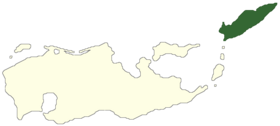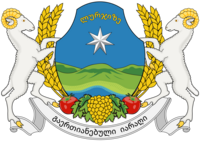San Estefano Island
Native name: წმინდა ესტეპანოს კუნძული Isla de San Estefano | |
|---|---|
 Location of San Estefano Island in green | |
| Etymology | Named for Saint Stephen after being discovered on the day of his feast |
| Geography | |
| Location | Southern Ocean, northeast of Lurjize |
| Archipelago | 26 December island cluster |
| Area | 87,583 km2 (33,816 sq mi) |
| Area rank | 2nd (Lurjize) |
| Coastline | 1,747 km (1,085.5 mi) |
| Highest elevation | 2,081 m (6,827 ft) |
| Highest point | Tsisghmerti |
| Administration | |
| Province | Tsminda Estepano |
| Capital and largest city | Paluri |
| Demographics | |
| Demonym | Estefan |
| Population | 5,548,200 (2020) |
| Languages | |
| Ethnic groups | |
| Additional information | |
| Time zone |
|
San Estefano Island (Lurjizean: წმინდა ესტეპანოს კუნძული; transliteration: ts’minda est’ep’anos k’undzuli) is the most populous island of Lurjize, and second largest (after the Lurjizean mainland). Located approximately 500km to the northeast of the Lurjizean mainland, San Estefano has a population of over 5.5 million, or nearly 3/5 of the Lurjizean population, as of 2020. San Estefano island covers about 87,600 square kilometers, making it the TBDth largest island in the world. San Estefano Island has an oceanic climate at low altitudes, and is only one of two Lurjizean islands where industrial-scale agriculture is practiced.
Archaeological findings suggest that humans have continuously inhabited San Estefano Island since roughly 3,400 BCE. The Gagsaplavi archaelogical site, established at around 1,800 BCE, is the earliest known permanent settlement on San Estefano Island. Several city states had existed on San Estefano prior to Creeperian arrival, with the Old Lurjizean language being developed between the 3rd and 6th centuries. In 1413, Joaquin Valladares landed on San Estefano Island while trying to navigate to the San Carlos Islands, then a Captaincy General of Creeperopolis. In 1462, the Captaincy General of the San Estefano Islands was created from the San Carlos Islands, with its seat being Ciudad Grande del Martir San Estefano.
History
Pre-colonial history
The earliest definitive trace of human activity on San Estefano Island can be traced back to the migration of the Proto-Creeperans from present-day Creeperopolis due to food insecurity caused by the region reaching its carrying capacity before the advent of agriculture in Sur. The extent of which the Proto-Creeperans were a seafaring people are unknown, as well as whether they were aware of the Lurjizean landmass or not. However, starting in around 3,500 BCE, archaeological records suggest that Proto-Creeperian immigration to the Lurjizean landmass began, with this continuing for several centuries. Though Proto-Creeperans did not reach San Estefano Island before the Lurjizean mainland, the vast majority of them eventually settled on the island due to its ideal climate, making the island suitable for hunting and gathering activities.
Many Lurjizean anthropologists believe that the Gagsaplavi archaelogical site is the key to understanding early history of both the island and the nation. Carbon dating suggests that the Gagsaplavi settlement was established sometime around 1,800 BCE; The settlement consisted of several permanent stone buildings and possibly housed several thousands at its peak. Furthermore, experts argue that the existence of the Gagsaplavi settlement indicates the practice of agriculture by indigenous Lurjizeans, as well as the existence of religion. Other sites, such as the site at Dzvlisgatkhra, corroborate this theory due to the presence of worship structures and/or tools used in agriculture.
Creeperian arrival
Captaincy General
Post-independence
Modern history
Geography
Biodiversity
Climate
Demographics
Population
| Year | Pop. | ±% |
|---|---|---|
| 1800 | 2,139,230 | — |
| 1884 | 2,891,124 | +35.1% |
| 1919 | 4,274,188 | +47.8% |
| 1949 | 5,088,320 | +19.0% |
| 1975 | 5,572,922 | +9.5% |
| 1990 | 6,057,524 | +8.7% |
| 2005 | 5,881,092 | −2.9% |
| 2020 | 5,548,200 | −5.7% |
Compared to the more Lurjizean mainland, San Estefano Island has a much larger, more diverse population of 5,548,200 as of 2020, a decrease of -5.7% as of the 2005 Lurjizean census. Lurjize's population is expected to continue decreasing due to an aging population, high death rates due to a weak healthcare system and lingering poverty, and emigration to wealthier nations. In 2020 , the average total fertility rate (TFR) in Lurjize was 1.83 children per woman, below the replacement rate of 2.1 and considerably below the historical high of 5.4 children per woman recorded in 1884. The island has an estimated average fertility rate of 1.72 children per woman, below the national average. Furthermore, the island has an average age of 39.8 years, higher than the national average of 37.5 years. 68.4% of San Estefano's population live in urban areas, with the Paluri metropolitan area accounting for 43% of the island's population. As of the 2020, there were 2,690,877 males and 2,857,323 females, giving the island a sex ratio of 0.97 males/female, higher than the national rate of 0.94 males/female. One possible explanation for this is the higher rates of gang-related violence and crime on the Lurjizean mainland and other islands, resulting in more male deaths. Of the total population, 20% (1,109,640) were 0-14 years of age, 65.4% (3,628,500) were 15-64, and 14.6% (810,000) were 65 or older.
Ethnic groups
Economy
Transport
Road transport
San Estefano Island has a state-maintained highway network of approximately 23,476 kilometres (14,587 mi). The M1 highway, known as the San Estefano Motorway, connects Paluri to the coastal ports of Agurik in the southwest and Tavisebi in the northeast, stretching for 517 km (321 mi). The highway was fully upgraded to a limited access route in 1994, but has existed since 1949. Other major highways on San Estefano Island include the Magistrali M3, which links the tourist destination of Puerto Caleta to Lurjize's road network, and the Magistrali M201, known as the Paluri Loop. In addition to this, the island has 7,828 kilometres (4,864 mi) of Shemobruneba routes.

